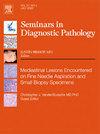胰腺导管腺癌及其变异的组织病理学和遗传学研究
IF 3.5
3区 医学
Q2 MEDICAL LABORATORY TECHNOLOGY
引用次数: 0
摘要
胰腺导管腺癌(PDAC)仍然是一种致命的疾病,适当的病理评估确保适当的临床管理。这篇综述文章总结了关于PDAC评估中存在的问题、不常见和新的挑战的文献,并强调了最近的分子进展。显微镜下,PDAC的形态多样,某些特征,如泡沫腺体形态、大导管浸润模式、导管癌变和新辅助治疗效果,对识别和区分模仿者很重要。免疫组织化学可用于区分良性和恶性胰腺上皮。PDAC的形态亚型有其独特的临床、组织学和分子特征,为了解疾病机制和治疗提供了依据。最后,靶向分子改变的治疗可以显著影响一些患者,通过详细的转录组学评估,PDAC的分子分型在过去十年中迅速发展。本文章由计算机程序翻译,如有差异,请以英文原文为准。
Histopathological and genetic landscape of pancreatic ductal adenocarcinoma and its variants
Pancreatic ductal adenocarcinoma (PDAC) remains a deadly disease where proper pathologic evaluation ensures appropriate clinical management. This review article summarizes literature regarding problematic, uncommon, and new challenges in PDAC evaluation and highlights recent molecular advancements. Microscopically, the morphologies of PDAC are diverse, and certain features, such as foamy gland morphology, large duct pattern of invasion, cancerization of ducts, and neoadjuvant therapy effects, are important to recognize and distinguish from mimickers. Immunohistochemistry can be useful in select settings for distinguishing malignant from benign pancreatic epithelium. Morphologic subtypes of PDAC have their own distinct clinical, histologic, and molecular features that provide insight into disease mechanisms and therapy. Finally, therapies targeting molecular alterations can significantly impact some patients, and molecular subtyping of PDAC has rapidly advanced in the last decade through detailed transcriptomic evaluation.
求助全文
通过发布文献求助,成功后即可免费获取论文全文。
去求助
来源期刊
CiteScore
4.80
自引率
0.00%
发文量
69
审稿时长
71 days
期刊介绍:
Each issue of Seminars in Diagnostic Pathology offers current, authoritative reviews of topics in diagnostic anatomic pathology. The Seminars is of interest to pathologists, clinical investigators and physicians in practice.

 求助内容:
求助内容: 应助结果提醒方式:
应助结果提醒方式:


